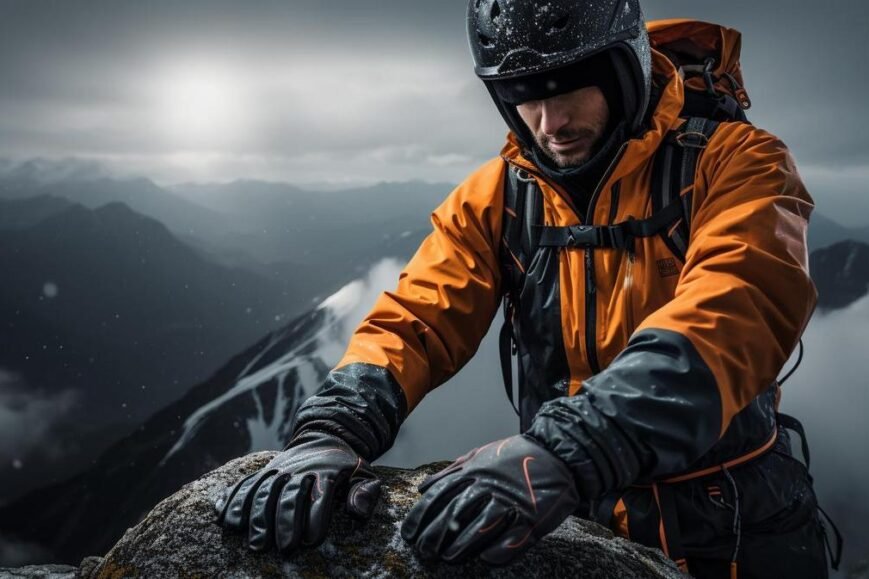- Hiking gloves protect against cold, UV rays, and scratches, and improve grip.
- For summer hikes, choose lightweight, breathable gloves with UV protection and a snug fit.
- Waterproof gloves have a water-blocking layer and sealed seams; care for them with gentle cleaning and air drying.
- Fingerless gloves offer a balance of dexterity and protection in mild weather but aren’t suitable for cold, rough hikes.
- Durable gloves feature insulation, grips, thermal/windproofing, reinforced areas, and strong stitching.
- Extreme cold weather gloves should be made from materials like fleece or neoprene, possibly with room for liners to increase warmth.
Hey outdoor lover! Ever wonder what gloves you should grab for hitting the trails? You need the right pair to keep your hands safe and comfy while you trek. The best hiking gloves do more than you might think. They protect you from cold, cuts, and sunburn.
They help you hold on tight when you scramble over rocks. And guess what? Gloves aren’t just gloves. Some are for kids, others fit everyone, and yeah, there are even mittens. Stick with me, and I’ll walk you through what makes a pair of hiking gloves a must-have for your next adventure. Let’s get our hands on some know-how and ensure you choose the best protection for your outdoor journeys!
Why Are Gloves Important for Hiking?
What gloves are good for hiking?
The best hiking gloves shield your hands, keep your grip firm, and aid in holding gear.
Gloves protect against cold, cuts, and sunburn. They also help you grab things safely. For hikes, you want gloves that avoid harm and let you move your fingers well. Hiking gloves with dexterity are key. They must fit well and keep your hands safe.
Why do hikers wear gloves?
They wear gloves to guard against weather and injuries.
In the cold, gloves are a shield from frostbite. Gloves also prevent scratches and blisters. On sunny paths, they can protect skin from harsh UV rays. A good pair of unisex hiking gloves works for anyone.
When picking gloves, remember kids need them too. Hiking gloves for children should be snug but not tight. They should keep little hands warm and safe on the trail.
Some hikers choose hiking mittens. Mittens keep hands warm but limit finger use. Gloves give more freedom to use fingers. This makes gloves better for most hiking needs.
A unisex design can fit all hikers well. This makes buying gloves easier. Look for gloves that fit your hiking needs and keep your hands safe from harm.
What Should You Look for in Summer Hiking Gloves?
When it comes to summer hiking gloves, what matters most? Think light, cool, and comfy. Lightweight hiking gloves are key. They should not add extra hand weight. Instead, they keep you moving with ease. Summer hikes often mean sun up above. Your hands need protection from those rays. Look for sun protection gloves for hiking to shield your skin.
What material are hiking gloves? For summer, pick breathable fabrics. These let air flow and prevent sweat build-up. Materials like mesh or thin synthetics usually do best for summer. They keep your hands dry and cool while you tackle the trail.
UV rays can damage skin over time. Summer hiking often exposes you more. So, the gloves you choose must block harmful UV light. This feature keeps your hands safe on sunny treks.
Size and fit also matter. Gloves too tight can make your hands feel trapped. Too loose, and they may slip or cause blisters. Aim for a snug yet comfy fit. This ensures full hand motion without restrictions. It also helps you maintain a good grip and dexterity.
Remember these traits when you shop. Lightweight, breathable, and UV-protecting features are best. Always try them on to confirm the fit. Then, hit the trails knowing your hands are ready for the journey.
How Do Waterproof Hiking Gloves Keep You Dry?
Waterproof hiking gloves keep water out. They are different from water-resistant gloves. Waterproof gloves have special materials that block water. Water-resistant gloves slow water down but can’t stop it completely. The best waterproof hiking gloves use tech to keep hands dry. They will have features that shed water fast.
For dry hands on trails, look for gloves with these features. They must have a waterproof layer. This can be a coating or a membrane. The layer keeps water away while letting sweat go out. Gloves for hiking in the rain should also have sealed seams. This stops water from seeping in. These gloves are often called quick-drying gloves for trails. They have fabric inside that pulls sweat away, so your hands stay dry.
To care for waterproof gloves, follow these tips. Always clean them according to the label. Let them dry naturally. Do not put them near high heat. This can damage their waterproof parts. Do not forget to treat the gloves with water repellent if needed. This will keep their waterproof power strong after lots of use.
When hiking, your hands face rain, snow, and rivers. Stay ready with the right gloves. They will help your adventure in the wild go smoothly.
Can You Hike Comfortably with Fingerless Gloves?
Yes, you can hike with fingerless gloves. They offer a snug fit and help you grip things well. You feel the breeze on your skin but still keep control of your poles. In warm weather, they let your hands breathe and stay cool.
When you pick fingerless gloves for trails, look for sturdy, cool fabrics. Nylon and spandex are good. They are tough and dry fast. Look for gloves with padded palms. This helps you hold your trek gear tight without slipping.
In mild, dry weather, fingerless gloves work great. They are also good when you need to use your fingers a lot. For tasks like using your phone or opening a snack, they are perfect. You won’t need to take them off every time.
But in the cold or during long, rough hikes, full gloves are often better. They cover all of your hands. This keeps you warm and safe from scrapes. In the end, the choice between fingerless and full gloves depends on the weather and your hike. Choose what fits the trip and what feels right to you.
Which Features Enhance the Durability and Functionality of Hiking Gloves?
Are insulated hiking gloves important? Yes, they keep your hands warm. Insulated gloves trap heat. This keeps your fingers from going numb. In cold weather, this is a lifesaver. Look for gloves that have insulation. But make sure they don’t feel too bulky. You still want to move your fingers easily.
The grip is also key for trekking terrains. Think about rough paths and rocky climbs. You need gloves that help you hold on tight. Many gloves have rubber or silicone pads. These pads give you a better grip. They help you hold hiking poles and climb safely.
Thermal hiking gloves and windproof features matter too. Thermal gloves keep your hands warm on chilly days. Windproof gloves block cold air. So, your hands stay warm even in strong winds. Pair these with insulation and grip. You’ll have gloves that can handle most trails.
What makes gloves last longer? Look for tough materials. Leather or synthetic fabrics can take more wear and tear. Reinforced palms and fingertips add to glove life. These spots wear out the quickest. So, extra material there helps.
Stitching matters too. Double or triple stitching means stronger seams. It stops the gloves from falling apart. A good fit also adds to durability. Tight gloves stretch and tear more easily. But gloves that are too loose can snag and rip. Find gloves that fit just right. They’ll last longer and keep you safer on your hikes.
How to Choose Hiking Gloves for Extreme Weather Conditions?
What gloves are the best for extremely cold temperatures? It would help if you had gloves built to handle the chill, such as extreme cold weather hiking gloves or winter hiking gloves. These types keep hands warm in snow and ice.
For hard-core winter hikes, materials make all the difference. Fleece gloves are great for warmth. They feel soft and hold heat. Then, there are neoprene gloves for hiking. Neoprene keeps the cold out, even when wet.
Let’s dive into the details. Fleece gloves for the outdoors are cozy. They’re perfect for dry, cold days. But fleece might not do the job when it’s wet or super windy. That’s where neoprene comes in handy. It’s the stuff wetsuits are made from, so it can handle wet, windy weather like a champ.
Now, fleece and neoprene have their perks. But in the worst conditions, you might want more. Consider gloves that have room for liners. This way, you can add extra warmth if needed. Also, layering is smart. Start with a thin liner, then wear heavier gloves on top. This works well because you can adjust on the go.
To sum it up, look for gloves made from the right stuff. Fleece is for dry, cold hikes, and neoprene is for wet, wild ones. And remember, layers and liners can be lifesavers when the weather goes from cold to extreme. Stay warm and safe out there.
Conclusion
We covered a lot about hiking gloves, from summer sun protection to cold-proofing your hands. Picking the right pair means you can climb, grab, and stay safe on trails. Remember, mittens keep you warm, gloves give you grip, and for kids, look for tough fits. In rain, go for waterproof, not just resistant. If you want some finger freedom, fingerless might be your pick. For tough paths, durability matters, and in extreme cold, insulation is key. Get gloves that meet your needs and happy trails!
![]()

